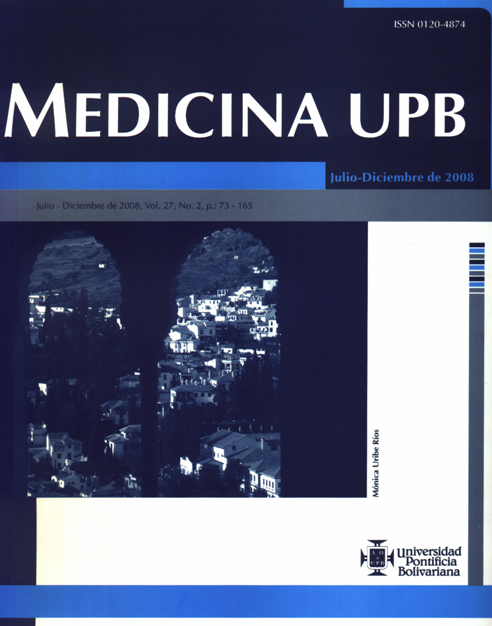Enfermedad cerebrovascular y trastornos de hipercoagulabilidad en pacientes con cáncer: reporte de caso y revisión de la literatura
Contenido principal del artículo
Resumen
La Enfermedad Cerebrovascular (ECV) es una entidad que puede tener diversas etiologías, considerando el Cáncer (CA) como una de éstas, ya sea dentro del contexto de las lesiones metastásicas o dentro de los trastornos de hipercoagulabilidad. Se reporta en la literatura que aproximadamente el 15% de los pacientes con CA desarrollan ECV en el transcurso clínico de su enfermedad. El CA y la ECV en su orden son la segunda y tercera causa de muerte en los Estados Unidos respectivamente. Desafortunadamente la coexistencia de CA y su respectivo tratamiento incrementa el riesgo de ECV y las comorbilidades acentúan la morbilidad y la mortalidad. Se describe a continuación el caso clínico de un paciente que presentó un evento vascular isquémico cerebeloso derecho con extensión a vermis y compromiso del tallo cerebral, presentando además deterioro neurológico progresivo. Sin factores de riesgo para enfermedad vasculares cerebral conocidos; durante la realización de una endoscopia para determinar la viabilidad de gastrectomía por compromiso de los reflejos de deglución, se observó una masa gástrica que posteriormente fue reportada como adenocarcinoma difuso Borrman I. Se realiza una revisión del tema y métodos diagnósticos.
Referencias
Nguyen T, Angelis L. Stroke in cancer patiens. Curr Neurol Neurosci Rep. 2006;6:187-192
Trousseau A. Phlegmasia alba dolens. En: Clinique Medicale de l’Hoˆtel-Dieu de Paris. Paris: Balliere ;1865. p.654 –712.
Cestari D, Weine D, Panageas K, Segal AZ. Deangelis LM. Stroke in patiens with cancer:Incidence and etiology. Neurology. 2004;62:2025-2
Arboix A.. Cerebrovascular disease in the cancer patient. Rev Neurol. 2000 Dec 16-31;31(12):1250-2.
Khaled S, Griffiths E, Streiff M. Nonbacterial thrombotic endocarditis in cancer patients: pathogenesis, diagnosis, and treatment. Oncologist. 2007;12;518- 523
Chaturvedi S, Ansell J, Recht L. Should cerebral ischemic events in cancer patients be considered a manifestation of hypercoagulability?. Stroke. 1994; 25:1215–1218.
Judy E, Garber. Oliva E. Case 28-1997— A 67-YearOld Woman with Increasing Neurologic Deficits and a History of Breast and Ovarian Cancer New England journal of medicine.
Newton HB. Neurologic complications of systemic cancer. Am Fam Physician. 1999; 59:878-886.
Kooiker JC, MacLean JM, Sumi SM. Cerebral embolism marantic endocarditis, and cancer. Arch Neurol. 1976 ; 33:260–264.
Behrendt CE, Ruiz RB. Cerebral ischemic events in patients with advanced lung or prostate cancer. Neuroepidemiology. 2005; 24:230–236.
Murata J, Sawamura Y, Takahashi A, et al. Intracerebral hemorrhage caused by a neoplastic aneurysm from small-cell lung carcinoma: case report. Neurosurgery. 1993; 32:124–126.
Graus F, Rogers LR, Posner JB. Cerebrovascular complicationsin patients with cancer. Medicine. 1985; 64:16–35.
Glass J, Hochberg FH, Miller DC. Intravascular lymphomatosis : a systemic disease with neurologicmanifestations. Cancer. 1993 ; 71:3156– 3164.
Madeline C, Levine R. Thrombophilias and Stroke: diagnosis, treatment, and prognosis. J Thromb Thrombolysis. 20(2) ; 113–126, 2005.
Birgitte H, Jerahme P, Richard L. Stroke in Young Adults and Children. Curr Neurol Neurosci Rep. 2001; 1:54–66.
Rogers L, Cho E, Kempin S, Posner J. Cerebral infarction from non-bacterial thrombotic endocarditis. Clinical and pathological study including the effects of anticoagulation. Am J Med. 1987; 83:746–756
Feinberg W, Swenson M. Cerebrovascular complications of L-asparaginase therapy. Neurology. 1988; 38:127– 133.
Mitchell L., Andrew M, Hanna K, et al. A prospective cohort study determining the prevalence of thrombotic events in children with acute lymphoblastic leukemia and a central venous line who are treated with Lasparaginase: results of the Prophylactic Antithrombin Replacement in Kids with Acute Lymphoblastic Leukemia Treated with Asparaginase (PARKAA) Study. Cancer. 2003; 97:508–516.
Finelli P, Schauer PK. Cerebral sinus thrombosis with tamoxifen. Neurology. 2001; 56:1113–1114.
Coplin W, Cochran MS, Levine S, Crawford S. Stroke after bone marrow transplantation: frequency, aetiologyand outcome. Brain. 2001; 124:1043–1051.


